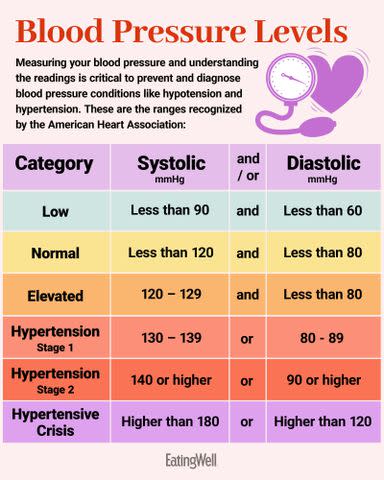5 Sneaky Signs You May Have Low Blood Pressure, According to Health Experts
If you’re wondering if you may have low blood pressure, then this piece is for you.

Getty Images
Reviewed by Dietitian Maria Laura Haddad-Garcia
Low blood pressure may be less common than high blood pressure, but that certainly doesn’t mean it’s not as concerning. In fact, the National Heart, Lung and Blood Institute states low blood pressure can lead to serious complications, including an increased risk of experiencing a heart attack and stroke.
Hypotension, or low blood pressure, is indicated when a blood pressure reading is less than 90 millimeters of mercury (mm Hg) over 60 mm Hg. However, what makes low blood pressure challenging to diagnose is that someone may or may not experience low blood pressure symptoms with this reading.
Low blood pressure is a condition many may be struggling with without knowing. In this article, we’ve talked to medical and nutrition experts to get the facts on what signs and symptoms may indicate it. Here are five sneaky signs they want you to be aware of.

EatingWell
1. Constant Dizziness
One of the symptoms people with low blood pressure may experience is constant dizziness.
Angelica Neison, M.D., CCMS, DipABLM, ABOM, notes, “I see an increase of cases with patients experiencing dizziness related to low blood pressure [due to a] decrease [in] salt and carbohydrate intakes. Because carbohydrates and sodium hang onto water, blood volume is lower, thus causing low blood pressure.” However, not every person who changes their diet will increase their risk of low blood pressure, and Neison explains that dizziness may have other causes: “Standing for prolonged periods of time without moving or compression from muscles can cause delayed blood flow back to the brain and lead to feelings of dizziness as well.”
2. Headaches and Blurry Vision
Hypotension can cause headaches and blurry vision, especially for those who suffer from hypotension related to position changes. A form of hypotension, known as orthostatic hypotension, can occur when an individual changes positions, such as going from sitting to standing, per MedlinePlus. Neison shares, “This occurs as blood flow back to the brain and body organs can be delayed in some individuals.” While this form of hypotension may lead to feeling dizzy and lightheaded in addition to headaches and blurry vision that usually passes quickly, in rare circumstances, it may also cause neck pain. If you experience prolonged pain in these areas, be sure to seek medical attention.
3. Fatigue and Lightheadedness
Those who experience low blood pressure may not receive adequate blood flow to the brain, making them feel tired, lightheaded and even faint. Melissa Azzaro, RDN, also known as The Hormone Dietitian, shares that these symptoms may be the same in females and males. However, females may easily confuse them with “symptoms many women experience from low blood sugar, undereating, not getting enough sleep, and or hormonal changes.”
While Azzaro advises clients to work with a trained dietitian or physician in hormonal health to determine what is causing the feeling of fatigue, she also shares, “In early pregnancy, low blood pressure is quite common, and one of the reasons why women may faint during the early months of pregnancy. Another time in a woman's life when low blood pressure may become an issue, is if they are experiencing heavy bleeding or blood loss, as with a heavier than normal period.” In these life stages, blood volume changes; thus, people experience a lack of blood flow to vital organs, which is why they may experience these feelings more so than males.
4. Rapid or Abnormal Heart Rate
Experiencing abnormal heart rhythms may also be another sign of low blood pressure. Neison shares, “Tachycardia, or an increased heart rate, may also be your body’s way of trying to tell you your blood pressure is low.” When this occurs, your body has difficulty delivering oxygen-rich blood to your vital organs. As a result, your heart compensates for this by pumping blood out more quickly to help deliver needed oxygen, resulting in an increased pulse yet lower blood pressure. If this occurs, or you notice any abnormal changes in your heart rate, be sure to seek medical attention immediately.
5. Excessive Sweating
Electrolytes are important to keep your fluid balanced in your body. Low blood pressure can result when you have an imbalance of electrolytes, such as sodium loss due to sweating. Neison shares, “2023 was the hottest summer recorded in history. Going outside during heat waves can lead to vasodilation, sweating, loss of sodium through sweat salts, and low blood volume in vulnerable populations. This, in turn, causes low blood pressure.” When this occurs, monitoring hydration and ensuring your blood pressure medications are appropriately dosed is crucial, especially if you take medicines for high blood pressure.
Related: The 6 Best Foods for Low Blood Pressure, According to Health Experts
Tips to Prevent Low Blood Pressure
Given the real complications of low blood pressure, it’s important to be proactive and implement healthy routines to keep your blood pressure as close to normal (for you) as possible. Azzaro recommends keeping these tips in mind to help manage low blood pressure:
Focus on Hydration: Staying hydrated is one of the most important ways to combat low blood pressure, since dehydration can lower your blood pressure. Water, herbal teas and even water-rich foods can all help with hydration needs.
Incorporate Vitamin B12- and Folate-Rich Foods: Eating a variety of foods, including foods that contain vitamin B12 and folate, can help keep your blood pressure within a healthy range. These two nutrients are key for red blood cells, which help carry oxygen throughout your body. When your cells can’t deliver the nutrients and oxygen your body needs to thrive, blood pressure will drop. And if a deficiency in either nutrient arises, anemia can result. Consuming lean meats, poultry, dairy and fortified foods can help prevent anemia.
Related: 7-Day Anemia Diet Plan to Help Boost Iron Levels
Increase Your Sodium Intake: Sodium consumption can help increase blood pressure, so people with high blood pressure should limit it. However, if you experience low blood pressure, eating adequate sodium can help raise it. Rather than turning to highly processed foods, consider adding fermented higher-sodium foods, like miso, to your salad dressings and dishes.
Exercise Regularly: Fitting in a regular exercise routine can help keep your blood pressure steady. When you exercise, blood volume increases as your heart pumps more blood to deliver oxygen to your body, helping maintain healthy blood pressure levels.
Seek Medical Help: Figuring out what's causing the low blood pressure and correcting that, whether it's undereating, dehydration or a medication that you're taking, is crucial to managing your health long-term.
Category | Systolic (mm Hg) | and/or | Diastolic (mm Hg) |
Low | Less than 90 | and | Less than 60 |
Normal | Less than 120 | and | Less than 80 |
Elevated | 120 - 129 | and | Less than 80 |
Hypertension | 130 - 139 | or | 80 - 89 |
Hypertension Stage 2 | 140 or higher | or | 90 or higher |
Hypertensive Crisis | Higher than 180 | or | Higher than 120 |
The Bottom Line
What is considered low blood pressure with health concerns is different for each individual. While a blood pressure reading of 90 mm Hg/60 mm Hg is the technical definition of low blood pressure, not everyone with that reading will experience symptoms. If you experience signs and symptoms like dizziness, fatigue and changes in heart rate, among others, document them and seek medical attention to help identify a tailored treatment plan for your health needs.
Related: The 5 Best Vegetables for Better Blood Pressure, According to a Dietitian
Read the original article on Eating Well.

